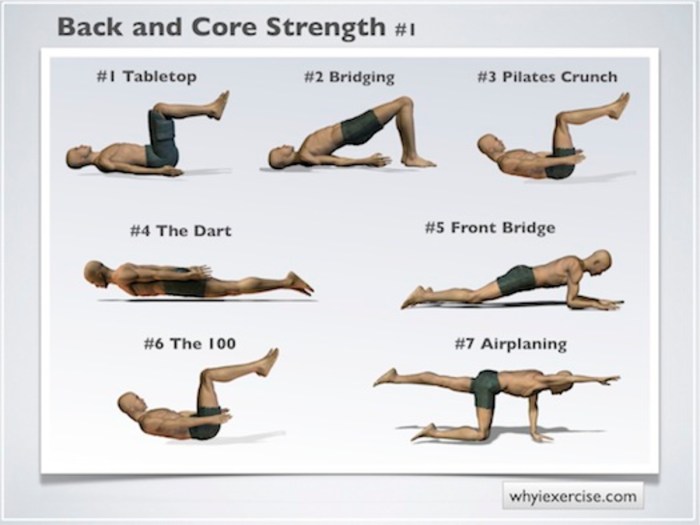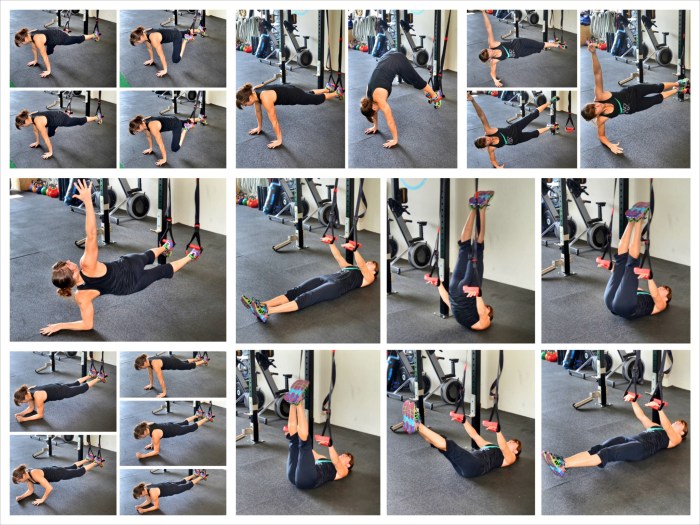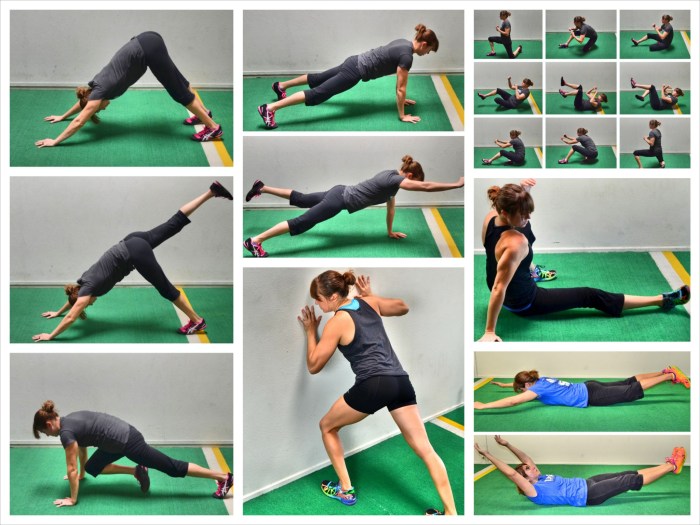Exercises for strength training are an essential component of any fitness routine, offering a wide range of benefits from building muscle and strength to improving athletic performance and overall health. In this comprehensive guide, we’ll delve into the fundamentals of strength training, providing you with the knowledge and tools you need to achieve your fitness goals.
From understanding the different types of exercises and their benefits to learning about progressive overload and training frequency, we’ll cover everything you need to know to create an effective strength training program. We’ll also provide tips for warming up, cooling down, and preventing injuries, ensuring that you get the most out of your workouts while staying safe.
Exercises for Major Muscle Groups
Strength training involves exercises that target specific muscle groups. To develop a balanced and strong physique, it’s important to incorporate exercises for all major muscle groups.
Chest Exercises
Chest exercises focus on building strength and definition in the chest muscles. Some common exercises include:
- Barbell Bench Press:Lying on a bench, lift a barbell from the rack and lower it to your chest, then press it back up to the starting position.
- Incline Dumbbell Press:Similar to the bench press, but performed on an inclined bench to target the upper chest.
- Dumbbell Flyes:Lying on a bench, hold dumbbells in each hand and lower them to the sides, then bring them back together at the top.
Back Exercises
Back exercises strengthen the muscles of the back, including the lats, traps, and erectors. Some common exercises include:
- Barbell Row:Stand with your feet hip-width apart, bend over at the hips, and row a barbell up to your chest.
- Pull-Ups:Hang from a bar and pull yourself up until your chin is above the bar.
- Deadlift:Stand with your feet hip-width apart, bend over at the hips, and lift a barbell off the ground.
Leg Exercises
Leg exercises target the muscles of the legs, including the quads, hamstrings, and glutes. Some common exercises include:
- Squat:Stand with your feet shoulder-width apart and lower your body by bending your knees and hips.
- Leg Press:Sit in a leg press machine and push a platform away from you with your legs.
- Hamstring Curl:Lie on a bench and curl your legs up towards your glutes.
Shoulder Exercises
Shoulder exercises strengthen the muscles of the shoulders, including the deltoids and rotator cuff. Some common exercises include:
- Overhead Press:Stand with your feet shoulder-width apart and press a barbell or dumbbells overhead.
- Lateral Raise:Stand with your feet shoulder-width apart and raise dumbbells out to the sides.
- Front Raise:Stand with your feet shoulder-width apart and raise dumbbells in front of you.
Arm Exercises
Arm exercises focus on building strength and definition in the biceps, triceps, and forearms. Some common exercises include:
- Bicep Curl:Stand with your feet shoulder-width apart and curl dumbbells up to your shoulders.
- Triceps Extension:Stand with your feet shoulder-width apart and extend dumbbells overhead.
- Hammer Curl:Stand with your feet shoulder-width apart and curl dumbbells up to your shoulders, keeping your palms facing each other.
Injury Prevention

Strength training can be a great way to improve your overall health and fitness, but it’s important to do it safely to avoid injuries. Common injuries associated with strength training include muscle strains and tears, ligament sprains and tears, and joint pain and inflammation.
There are a number of things you can do to prevent injuries, including:
Proper Form
Using proper form when lifting weights is essential for preventing injuries. This means using the correct technique and engaging the correct muscles. If you’re unsure about how to perform an exercise correctly, ask a qualified personal trainer for help.
Listening to Your Body
It’s important to listen to your body and stop if you feel pain. Pushing through pain can lead to serious injuries. If you experience any pain, stop the exercise and consult with a doctor or physical therapist.
Warming Up and Cooling Down
Warming up before you lift weights and cooling down afterward can help to prevent injuries. Warming up helps to prepare your muscles for exercise, and cooling down helps to reduce muscle soreness and stiffness.
Using Proper Equipment
Using the proper equipment can help to prevent injuries. This includes using the correct weight, using a weight belt when necessary, and wearing supportive shoes.
Gradual Progression
It’s important to gradually increase the weight you lift and the number of repetitions you do. Trying to do too much too soon can lead to injuries.
Additional Tips for Preventing Injuries
- Stay hydrated.
- Get enough sleep.
- Eat a healthy diet.
- Manage stress.
Training for Different Goals

Strength training can be tailored to specific goals, such as building muscle, losing fat, or improving sports performance. Each goal requires different training protocols to optimize results.
Training for Muscle Building
For muscle building, focus on heavy weights, low reps, and sufficient rest periods. Aim for 8-12 reps per set, with 2-3 sets per exercise. Rest for 2-3 minutes between sets. Train 2-3 times per week, targeting all major muscle groups.
Training for Fat Loss
For fat loss, emphasize higher reps, lighter weights, and shorter rest periods. Aim for 12-15 reps per set, with 3-4 sets per exercise. Rest for 1-2 minutes between sets. Train 3-4 times per week, incorporating compound exercises that work multiple muscle groups simultaneously.
Training for Sports Performance
For sports performance, training should be specific to the demands of the sport. This may involve a combination of strength, power, and endurance exercises. The frequency, intensity, and duration of training will vary depending on the sport and individual athlete.
| Goal | Sets | Reps | Rest Periods | Frequency |
|---|---|---|---|---|
| Muscle Building | 2-3 | 8-12 | 2-3 minutes | 2-3 times per week |
| Fat Loss | 3-4 | 12-15 | 1-2 minutes | 3-4 times per week |
| Sports Performance | Varies | Varies | Varies | Varies |
- For muscle building:Prioritize progressive overload, compound exercises, and adequate protein intake.
- For fat loss:Incorporate cardio, focus on calorie deficit, and consider HIIT workouts.
- For sports performance:Tailor training to specific sport demands, emphasize plyometrics and agility drills, and ensure proper recovery.
Importance of Nutrition and Recovery
Regardless of the training goal, nutrition and recovery play crucial roles in achieving success. A balanced diet, adequate hydration, and sufficient sleep are essential for muscle growth, fat loss, and overall health. Proper recovery allows the body to repair and rebuild, maximizing the benefits of strength training.
Nutrition for Strength Training

Proper nutrition is crucial for supporting strength training, providing the body with the essential nutrients it needs to build and repair muscle tissue, fuel workouts, and enhance recovery. Here’s an overview of the key nutritional considerations for strength training:
Protein Intake
Protein is essential for muscle growth and repair. Aim for a daily intake of 1.6-2.2 grams of protein per kilogram of body weight, distributed evenly throughout the day. Good protein sources include lean meats, poultry, fish, beans, lentils, and tofu.
Hydration
Staying hydrated is vital for overall health and performance. Drink plenty of water before, during, and after workouts to prevent dehydration, which can impair muscle function and recovery.
Other Essential Nutrients
In addition to protein and hydration, strength training requires a balanced intake of other essential nutrients, including:
- Carbohydrates for energy
- Fats for hormone production and cell function
- Vitamins and minerals for overall health and well-being
Meal Plan
Here’s a sample meal plan that includes nutrient-rich foods to support strength training:
- Breakfast:Oatmeal with berries and nuts, eggs with whole-wheat toast
- Lunch:Grilled chicken salad with quinoa, brown rice with beans and vegetables
- Dinner:Salmon with roasted vegetables, lentil soup with whole-wheat bread
- Snacks:Fruit, yogurt, protein shakes
Timing and Frequency
The timing and frequency of meals and snacks are important for optimal recovery and performance. Aim to consume protein within 30 minutes after a workout to maximize muscle protein synthesis. Regular meals and snacks throughout the day will help maintain energy levels and prevent muscle breakdown.
Supplements
Certain supplements can support strength training nutrition, including:
- Creatine:Enhances muscle energy production
- Beta-alanine:Buffers lactic acid accumulation during exercise
- BCAAs:Essential amino acids that promote muscle recovery
However, it’s important to consult with a healthcare professional before taking any supplements.
Equipment for Strength Training
Strength training equipment comes in a wide range, catering to various fitness goals and preferences. Understanding the types of equipment available and their suitability for your needs is crucial.
When choosing equipment, consider factors like your fitness level, strength training goals, and budget. Here are some common types of strength training equipment:
Barbells
- Straight bars with weights attached at both ends
- Used for compound exercises targeting multiple muscle groups simultaneously
- Provide a wider range of motion compared to dumbbells
Dumbbells
- Individual weights with handles
- Allow for unilateral movements, training each limb independently
li>Versatile, suitable for both isolation and compound exercises
Machines
- Fixed or adjustable devices with weight stacks or resistance bands
- Offer a guided range of motion, reducing risk of injury
- Can isolate specific muscle groups or target multiple joints
Kettlebells
- Weighted balls with handles
- Provide dynamic and functional movements, improving core strength and stability
- Suitable for explosive exercises like swings and snatches
Resistance Bands
- Elastic bands offering variable resistance
- Portable and affordable, allowing for workouts anywhere
- Provide both concentric and eccentric resistance, improving muscle endurance
Bodyweight Exercises, Exercises for strength training
- Exercises utilizing only your body weight as resistance
- Convenient and accessible, requiring no special equipment
- Can be modified to suit different fitness levels
Create Sample Workout Plans for Different Levels of Experience and Goals
Workout plans should be tailored to your fitness level and goals. Beginners should start with a simple plan that focuses on learning proper form and building a foundation. As you progress, you can gradually increase the intensity and complexity of your workouts.
Beginner Workout Plan
- Warm-up:5 minutes of light cardio, such as walking or jogging
- Exercises:
- Bodyweight squats: 10 reps
- Push-ups (on knees if needed): 10 reps
- Dumbbell rows: 10 reps per arm
- Plank: 30 seconds
- Sets:3
- Reps:10-12
- Rest:60 seconds between sets
- Workout frequency:2-3 times per week
- Cool-down:5 minutes of stretching
Mind-Muscle Connection

The mind-muscle connection refers to the ability to consciously engage and control specific muscle groups during exercises. This connection is crucial for effective strength training as it allows you to focus on targeting the desired muscles, leading to increased muscle activation and growth.
To develop a strong mind-muscle connection, it’s essential to pay attention to the following tips:
Focus on Form
- Maintain proper form throughout the exercises, ensuring that the target muscles are working correctly.
- Avoid using momentum or swinging motions that can compromise form and reduce muscle engagement.
Visualize Muscle Activation
- Imagine the specific muscle groups contracting and expanding during each exercise.
- Visualizing the muscles working can enhance neural activation and improve muscle recruitment.
Use Slow and Controlled Movements
- Perform exercises at a slower pace, allowing ample time for the target muscles to engage.
- Avoid rushing through exercises as it can diminish muscle activation and limit strength gains.
Mindful Breathing
- Coordinate breathing with the exercises, inhaling during the eccentric (muscle lengthening) phase and exhaling during the concentric (muscle shortening) phase.
- Proper breathing can enhance muscle oxygenation and support muscle engagement.
Practice Isolation Exercises
- Incorporate isolation exercises into your routine, which target specific muscle groups.
- Isolation exercises allow you to focus solely on activating the desired muscles, strengthening the mind-muscle connection.
Final Conclusion

Whether you’re a beginner just starting out or an experienced lifter looking to take your training to the next level, this guide has something for you. By following the principles Artikeld here, you can unlock the full potential of strength training and achieve your fitness goals.
Questions Often Asked: Exercises For Strength Training
What are the benefits of strength training?
Strength training offers numerous benefits, including increased muscle mass, improved strength and power, enhanced athletic performance, reduced risk of injuries, improved bone density, and boosted metabolism.
How often should I strength train?
The optimal frequency for strength training depends on your individual goals and fitness level. Generally, beginners can start with 2-3 sessions per week, while more experienced lifters may benefit from 3-5 sessions per week.
What is progressive overload?
Progressive overload is a fundamental principle of strength training that involves gradually increasing the weight, resistance, or volume of your workouts over time. This challenges your muscles and forces them to adapt, leading to increased strength and muscle growth.
Leave a Reply